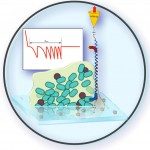Lien vers Pubmed [PMID] – 26000394
J Biomed Nanotechnol. 2014 Nov;10(11):3361-72.
Mechanical and conformational properties of type 1 fimbriae were evaluated on live bacterial cells by Single Molecule Force Spectroscopy (SMFS) and Dynamic Force Spectroscopy (DFS) in buffered solutions whose pH varied from 3 to 9. We evidenced that both fimbrial extension and fimbrial binding force to mannosylated-surface are modulated with changing the externally applied shear force and the solution pH. In particular, intertwined FimA-FimA and FimH-mannose interactions lead to a 5 to 25-fold decrease of the fimbrial unwinding for pulling rates larger than 10 μm/s and for pH values outside the range 5 to 7. In this pH range, the FimH-mannose binding force is maximal with a magnitude of -150-200 pN and the fimbriae extension reaches 8 μm. The enhancement of the FimH-mannose binding force at neutral pH, as evidenced from molecular AFM analyses, strongly correlates with an optimum in yeast agglutination detected at pH 5 to 7. The results reported in this work suggest that “catch bond effect” was negligible over the range of pulling rates tested, and both FimA-FimA and FimH-mannose interactions under given pH and external shear force conditions modify the ability of the bacteria to efficiently colonize host surfaces.




